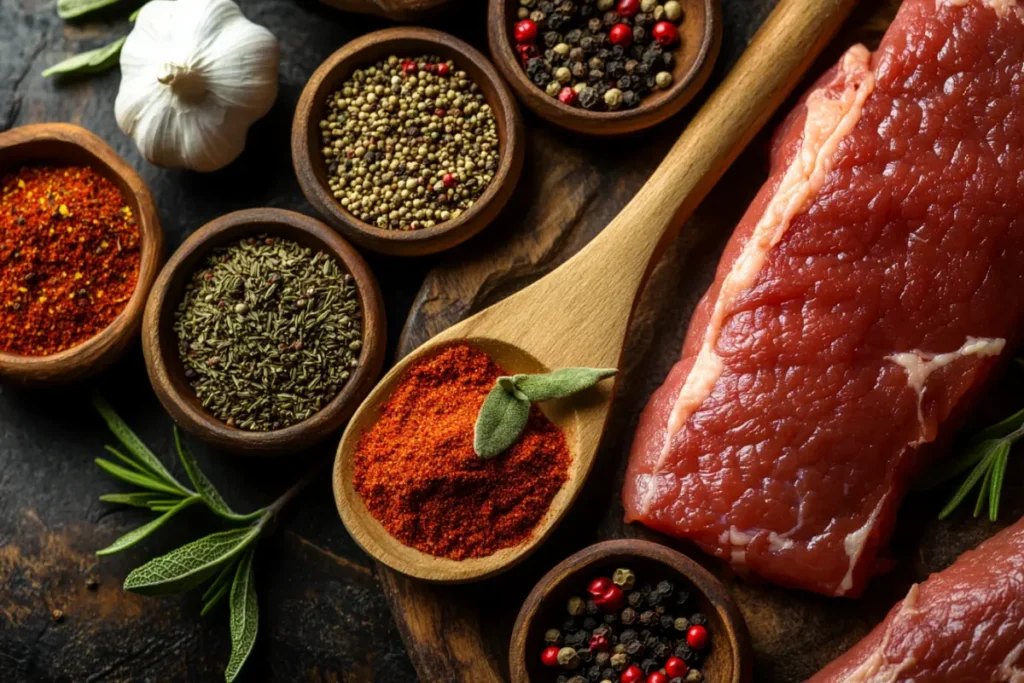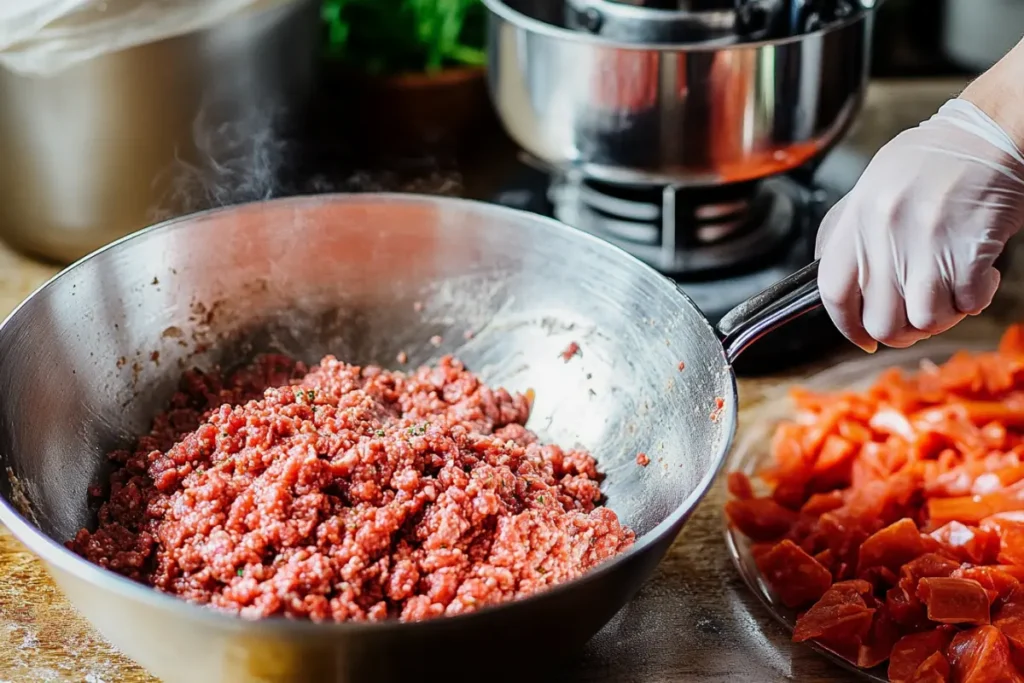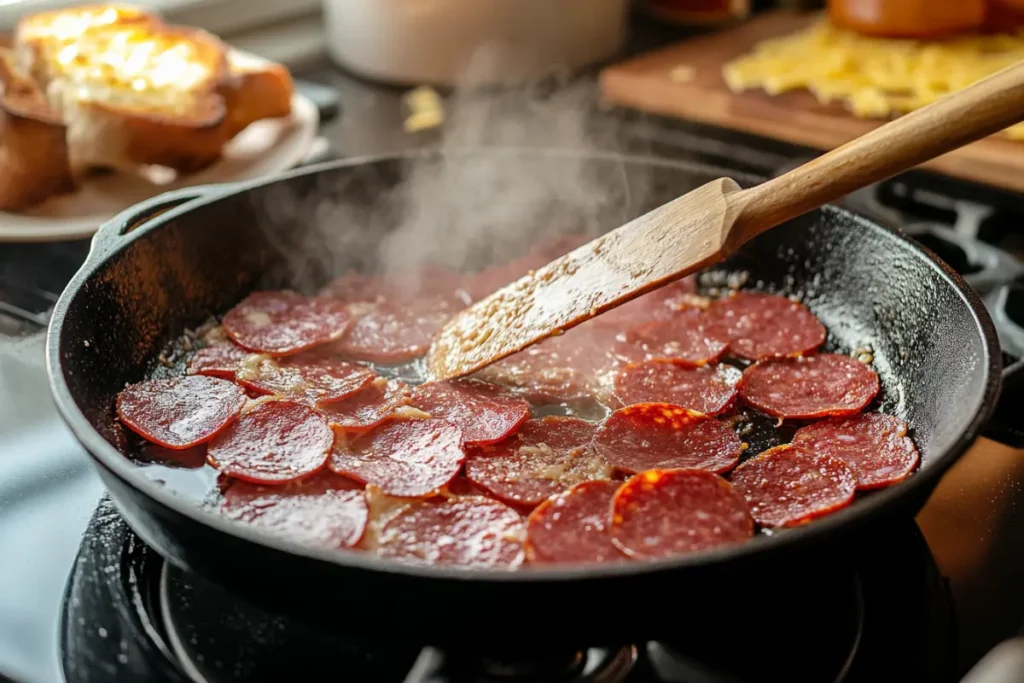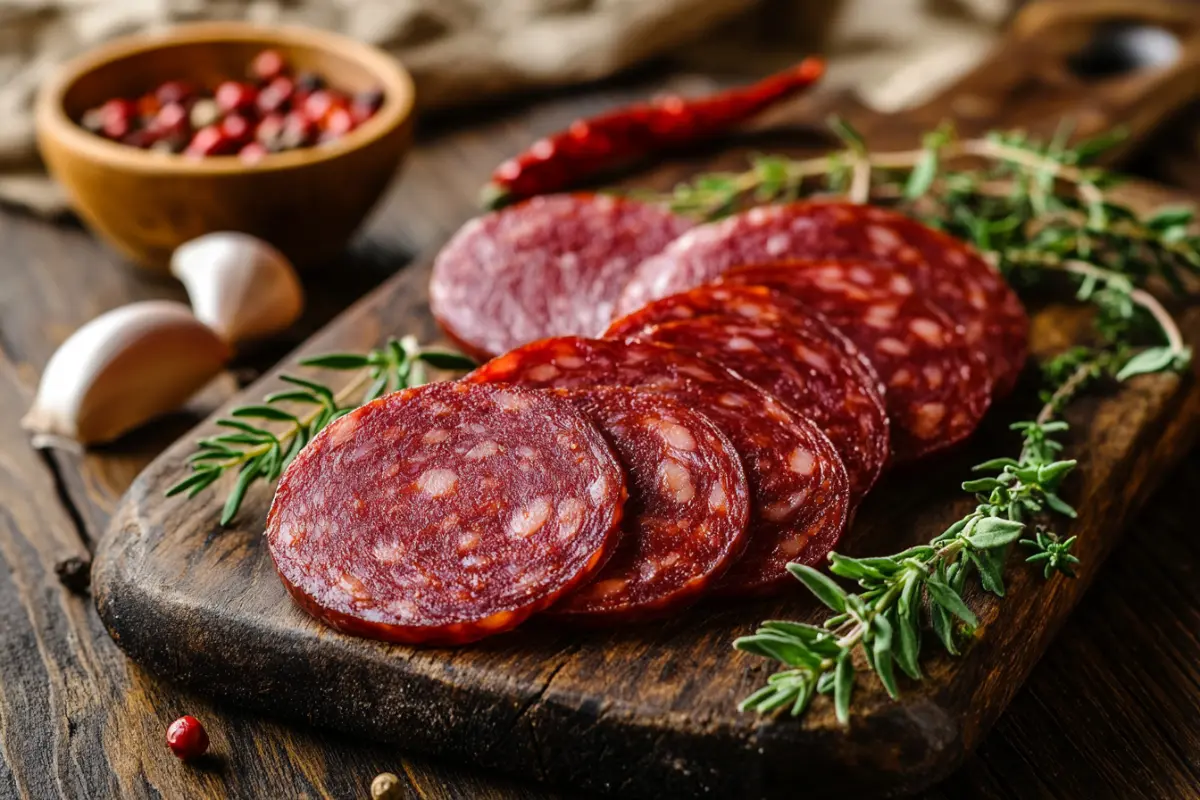Introduction
Craving a delicious, homemade version of beef pepperoni? You’re in the right place! Unlike store-bought options, making your own beef-based pepperoni ensures top-quality ingredients, rich flavor, and the perfect balance of spices. Whether you’re avoiding pork or just love the robust taste of beef, this guide will walk you through everything—from its origins to a step-by-step homemade recipe.
In this article, you’ll learn:
- What beef pepperoni is and how it differs from traditional pepperoni?
- The essential ingredients and techniques to make an authentic version at home.
- How to cook, store, and enjoy your homemade beef pepperoni in various dishes?
Let’s dive into the world of homemade charcuterie and create a mouthwatering beef pepperoni from scratch!
What is Beef Pepperoni?
Origins and History of Pepperoni
Pepperoni, a staple of American-Italian cuisine, traces its roots back to the early 20th century. This spicy, cured sausage was inspired by Italian salami but adapted to suit American palates with a smokier, spicier flavor. While traditional pepperoni is made from a blend of pork and beef, many people prefer beef pepperoni for religious, dietary, or taste reasons.
The shift toward all-beef varieties became popular due to the demand for halal and kosher alternatives. Today, beef pepperoni is widely enjoyed across different cultures, offering a unique flavor with a firmer texture than its pork-based counterpart.
Difference Between Beef Pepperoni and Traditional Pepperoni
So, what sets beef pepperoni apart? Here are the key differences:
- Meat Composition: Traditional pepperoni is a mix of pork and beef, whereas beef pepperoni is 100% beef.
- Flavor Profile: Beef-based pepperoni has a bolder, richer taste compared to the slightly sweeter pork variety.
- Texture: Beef tends to be leaner, making the final product denser and chewier.
- Fat Content: Pork pepperoni has more fat, which affects how it crisps when cooked. Beef pepperoni is slightly drier but just as flavorful.
Why Choose Beef Over Pork for Pepperoni?
Many people opt for beef pepperoni for a variety of reasons:
- Dietary Preferences: Those following halal, kosher, or pork-free diets can still enjoy the spicy goodness of pepperoni.
- Health Benefits: Beef contains more protein and iron, making it a slightly healthier alternative to pork.
- Flavor Variety: The robust, umami-rich taste of beef pepperoni pairs exceptionally well with smoky and spicy seasonings.
- Cooking Versatility: From pizzas to pasta, homemade beef pepperoni is a versatile ingredient that enhances a wide range of dishes.
Now that you understand what makes beef pepperoni special, let’s move on to gathering the right ingredients for making it at home! Stay tuned for Part 2, where we’ll break down everything you need to create the perfect batch.
Ingredients for Homemade

Essential Ingredients for Authentic Flavor
Making beef pepperoni at home starts with high-quality ingredients. To achieve the bold, smoky, and slightly spicy flavor, you’ll need a precise blend of spices and seasonings. Here’s what you’ll need:
- Ground beef (85% lean, 15% fat) – The best balance for texture and moisture.
- Curing salt – Helps with preservation and enhances flavor.
- Paprika – Adds a rich red color and subtle smokiness.
- Garlic powder and onion powder – For depth and aroma.
- Crushed red pepper flakes – Provides a mild to medium heat.
- Black pepper and white pepper – For a well-rounded spiciness.
- Fennel seeds – A classic ingredient in cured meats.
- Sugar or dextrose – Balances out the spices.
- Liquid smoke (optional) – Enhances the smoky profile.
- Cold water – Helps mix everything evenly.
Choosing the Right Beef Cut for Best Results
The foundation of great homemade beef pepperoni is selecting the right beef cut. Ideally, you should use chuck, brisket, or round, as these cuts have the right balance of lean meat and fat. Avoid extra-lean cuts, as they can make the final product dry and crumbly.
Seasonings and Spices for a Perfect Blend
The seasoning mix is what transforms plain beef into flavorful beef pepperoni. The combination of paprika, garlic, black pepper, and red pepper flakes creates the signature taste. You can also experiment with oregano, cayenne, and mustard powder for a unique twist.
Natural vs. Artificial Casing: What’s the Best Choice?
If you prefer a traditional sausage shape, you’ll need casings. Natural beef casings offer better texture, while collagen casings are easier to work with. If you want a casing-free version, you can shape the meat into logs and bake it.
Now that you have your ingredients ready, let’s move on to making beef pepperoni from scratch!
Step-by-Step Guide to Making Beef Pepperoni at Home

Preparing the Beef: Grinding and Seasoning
- Choose your beef cut – If using whole cuts, grind them with a meat grinder. Aim for a medium-coarse grind for the best texture.
- Mix the spices – In a bowl, combine all the seasonings, including paprika, black pepper, garlic powder, and curing salt.
- Blend with the meat – Add the spice mix to the ground beef, then pour in cold water to help distribute the flavors evenly.
Mixing Spices and Curing the Meat
For an authentic beef pepperoni taste, the mixture needs to cure properly. After mixing, cover the bowl and refrigerate for 24 to 48 hours. This allows the flavors to meld and the curing process to work its magic.
Stuffing the Casing or Shaping the Meat
If using casings:
- Soak natural casings in warm water for 30 minutes before use.
- Load the meat mixture into a sausage stuffer and carefully fill the casings, ensuring no air pockets remain.
- Twist into even links or leave as one long sausage.
For casing-free beef pepperoni:
- Shape the mixture into cylindrical logs.
- Wrap tightly in parchment paper or plastic wrap to hold their shape.
Drying, Fermenting, and Smoking for Authentic Taste
The key to authentic beef pepperoni is proper drying and smoking:
- Preheat the oven or smoker to 150-170°F (65-75°C).
- Hang or place the sausages on a wire rack, ensuring good airflow.
- Smoke with hickory or applewood for 4-6 hours for a deep smoky flavor.
- Dry in the refrigerator for a few days to enhance texture.
Storing and Aging
- Store in the fridge for up to 2 weeks or freeze for up to 3 months.
- If properly dried and cured, vacuum-sealed beef pepperoni can last for months.
How to Cook and Use

Baking vs. Pan-Frying: Which Method Works Best?
Once you’ve made your homemade beef pepperoni, it’s time to cook it to perfection. The method you choose depends on how you want to enjoy it.
Baking Method:
- Preheat your oven to 375°F (190°C).
- Place the beef pepperoni slices on a parchment-lined baking sheet.
- Bake for 8-10 minutes until crispy and slightly curled at the edges.
Pan-Frying Method:
- Heat a dry skillet over medium heat.
- Add beef pepperoni slices in a single layer.
- Cook for 1-2 minutes per side until crispy.
While baking is better for making large batches, pan-frying brings out more of the smoky, spicy flavors.
How to Slice and Store for Maximum Freshness?
To get the perfect pepperoni slices:
- Use a sharp knife or a meat slicer to get even, thin cuts.
- Store sliced beef pepperoni in an airtight container in the fridge for up to two weeks.
- For long-term storage, vacuum seal and freeze it for up to three months.
Tasty Ways to Use Beef Pepperoni in Recipes
Beef pepperoni is incredibly versatile and can enhance various dishes. Try these ideas:
- Classic Pizza Topping – A must-have for homemade pizza nights!
- Stuffed Sandwiches & Paninis – Adds a flavorful kick to grilled cheese or subs.
- Pasta & Lasagna – A delicious addition to baked ziti or spaghetti.
- Salads – Crisped-up beef pepperoni makes a great crunchy topping.
- Breakfast Dishes – Mix it into scrambled eggs or omelets.
For more creative ways to use beef pepperoni, check out some great recipes online!
Nutritional Benefits
Is Beef Pepperoni Healthier Than Pork Pepperoni?
Many people wonder if beef pepperoni is a healthier alternative to pork. While both are cured meats, beef offers some advantages:
- Lower Fat Content – Beef-based pepperoni tends to have less fat than pork varieties.
- More Protein – With high protein levels, it helps with muscle growth and energy.
- Iron-Rich – Beef is naturally high in iron, which supports red blood cell production.
- Fewer Additives (if homemade!) – When made at home, you can control the ingredients and avoid excessive preservatives.
Protein, Fat, and Sodium Content Analysis
Here’s a quick comparison of beef vs. pork pepperoni (per 1-ounce serving):
| Nutrient | Beef Pepperoni | Pork Pepperoni |
|---|---|---|
| Calories | ~130 | ~140 |
| Protein | ~6g | ~5g |
| Fat | ~10g | ~12g |
| Sodium | ~450mg | ~500mg |
While beef pepperoni is slightly lower in fat, both types should be enjoyed in moderation due to their high sodium content.
How to Make a Healthier Version at Home?
If you want a healthier homemade beef pepperoni, try these tips:
- Use leaner beef cuts like sirloin to reduce fat.
- Replace curing salt with natural alternatives like celery powder.
- Reduce sodium by adjusting the salt content in your spice blend.
- Store properly to avoid the need for excessive preservatives.
With these tweaks, you can enjoy a guilt-free version of beef pepperoni without compromising on flavor!
Common Mistakes to Avoid
Overcooking or Undercuring the Meat
One of the biggest mistakes when making homemade beef pepperoni is not allowing enough curing time. Curing helps develop the distinct pepperoni flavor and preserves the meat. If you rush the process, your beef pepperoni may taste bland and spoil quickly.
On the other hand, overcooking during smoking or baking can make the pepperoni dry and tough. Always follow recommended cooking times and temperatures to maintain the right texture.
Not Using the Right Spices or Seasoning
Getting the seasoning right is crucial for authentic beef-based pepperoni. Some common mistakes include:
- Skipping paprika, which gives pepperoni its signature red color and mild smokiness.
- Not balancing salt and sugar, leading to an overly salty or bland taste.
- Using too little garlic and black pepper, resulting in weak flavor.
Stick to the spice blend outlined in Part 2 for the best results!
Storage Mistakes That Affect Flavor and Shelf Life
Improper storage can ruin the taste and texture of your beef pepperoni. Here’s what to avoid:
- Leaving it at room temperature for too long, which can cause spoilage.
- Not vacuum-sealing or refrigerating properly, leading to freezer burn or mold.
- Slicing it too early before it’s fully dried and set.
Always store beef pepperoni in an airtight container in the fridge or freezer for maximum freshness.
FAQs
1. Can I make beef pepperoni without curing salt?
Yes! While curing salt helps with preservation and authentic flavor, you can use natural curing agents like celery powder or Himalayan salt. However, the pepperoni may not last as long and will have a milder cured taste.
2. How long does homemade beef pepperoni last?
If stored properly:
- In the fridge – Up to 2 weeks in an airtight container.
- In the freezer – Up to 3 months when vacuum-sealed.
- Dried and aged – Can last several months if stored in a cool, dry place.
3. Can I make beef pepperoni without a meat grinder?
Absolutely! If you don’t have a grinder, you can:
- Ask your butcher to grind the meat for you.
- Use pre-ground beef (85% lean, 15% fat) for convenience.
- Finely chop the meat by hand for a more rustic texture.
4. What’s the best way to store homemade beef pepperoni?
For best results:
- Wrap it tightly in plastic wrap or parchment paper before refrigerating.
- Use vacuum-sealed bags for longer storage.
- Store in a cool, dry place if it’s fully dried and cured.
Conclusion
Making beef pepperoni at home is a rewarding process that lets you control the ingredients, flavor, and texture. Whether you prefer it spicy, smoky, or mild, you can tweak the seasonings to match your taste. Plus, with proper curing and storage, your homemade beef-based pepperoni can last for weeks!
Now that you know how to make, cook, and store beef pepperoni, why not try it in your next homemade pizza, sandwich, or pasta dish?

